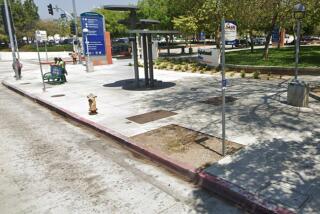The Hazards of Transit Crime
- Share via
Nearly 1.7 million passengers ride the bus every day in Los Angeles. Most passengers go to and from work or school without incident, but something under 1,000 of them a year--by the count of transit officials--become victims of crime, a problem on most big-city public transit systems.
Petty thieves lift wallets and steal from purses in the back of some buses and at some crowded bus stops. Young hoodlums, ever ready for a fight, bring gang rivalries aboard with them and violence swirls into other passengers.
Like other big-city systems, the Southern California Rapid Transit District has taken steps to reduce crime. But the Los Angeles County Board of Supervisors, on the motion of Ed Edelman, wants to know if the transit officials are doing enough, in light of a recent UCLA study on bus crime.
The UCLA researchers and RTD officials agree that crime is a problem--much more so in Los Angeles than in Orange County--but UCLA’s estimates, which include incidents on the way to and from the bus and at the bus stop, are 20 to 30 times higher than RTD figures, which include only incidents on the bus. In response to the UCLA study, transit officials have challenged the researchers’ methods.
The board has asked the RTD to respond to the UCLA study within 60 days. The transit authority has also been asked to determine whether the system can afford to let out-of-uniform police officers ride free, as they once did, and to determine what can be done to strengthen police protection near the most crime-ridden bus stops.
Although the county Board of Supervisors lacks the authority to order the RTD to take action, the board does appoint five RTD directors. Edelman’s motion, however, does not say where the money will come from if the RTD identifies public-safety ideas that are beyond the budget constraints.
Extra transit police already are assigned to the worst stops, and drivers can summon police with silent alarms. As soon as 900 buses are outfitted with cameras, drivers will be able to see more clearly what’s happening in the back of the bus, where much of the trouble takes place.
For some passengers, taking the bus is a way to escape driving on crowded freeways and in record-breaking traffic jams. For youngsters not old enough to drive, bus trips allow adventures to the beach, the movies or baseball games.
But for people who do not own a car, buses are crucial to life. The RTD owes all of them a stronger response than mere criticism of the methodology of a study that says there are ways to reduce the hazards of taking a bus.
More to Read
Sign up for Essential California
The most important California stories and recommendations in your inbox every morning.
You may occasionally receive promotional content from the Los Angeles Times.













